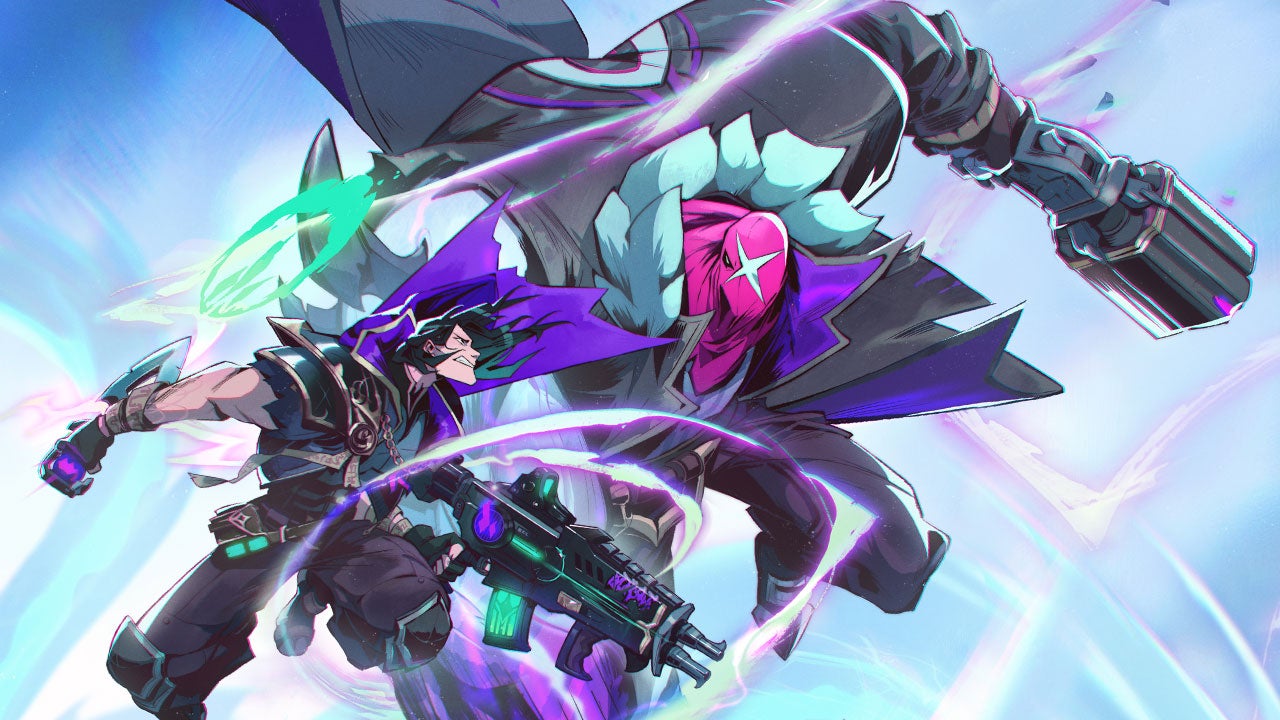From the outside, Survive looks like a lot of twin-stick top-down shooters that you can see in any digital game store. It only takes a few minutes of entering its massive battle royale-style map to see that it doesn’t just look like the beautifully modeled and animated PC action game you may be familiar with, but combines elements from many games from many genres to create a battle royale that is completely unique, with a surprising amount to learn and do in each session beyond surviving against other teams. Clashes against enemies are frenetic thanks to a heavy emphasis on fast and varied movement styles and cleverly designed characters with abilities that interact with each other and their surroundings in far more interesting ways than just dealing damage.
These so-called Hunters are really the first place I was particularly blown away by Survive. Of the 14 available to me, all had completely different game plans for success in battle. Some characters were pretty obviously weird out of the gate, like this crowd controller, but even the ones that would be fairly straightforward in any other game had a feature that made them really pop. Huntress, for example, is the bow wielder, which means she has the attacks you’d expect from this archetype – like the ability to shoot a large arrow over a greater distance, or a fan of arrows in an area in front of you. But she can also move through walls like an X-Man, making her much more elusive than you’d expect for a character who has to take extra time to aim relatively slow shots.
Support or utility focused hunters are very effective during combat in active ways. Pushing enemies with a rapidly expanding wall or rushing to fallen comrades to save them from execution are just some of the small ways that Survive freshens up a role that’s usually more passive. In fact, no matter who you choose, be it a fast ranged shooter or a frontline face shot, you’ll have some sort of movement and displacement ability, meaning you can always move your position to avoid enemy attacks or directly disrupt the opponent. The seamless movement around the map and in, out, and through combat, mixed with the many ways you can suddenly move your enemies out of position, into walls, or even into each other, makes this game so noticeably different from other tactical games like League of Legends or Battlerite, from which it draws a lot of inspiration. You can be elusive and aggressive in the same move, which feels more like roguelike fighting games than would be typical in a shooter like this. Most characters don’t have to wait for the proper opening, they can do it themselves.
Before you even get to open combat with enemies, you’ll probably need to find them first. Survive’s vast map is full of regions that hide treasures within. In the sessions I had, after selecting a map location and dropping in, there was always a small scouting period where we had to check our surroundings for opportunities to gain loot or experience. Our first few encounters were usually with groups of NPC monsters either roaming around locations or camped around corners waiting for unsuspecting players. Rarely were these monsters more than a nuisance on their own, but higher-level bosses can test your team’s strength, and any mob camp wedged in between a fight between enemy teams can often be an afterthought for them. The map has a day and night cycle that makes monsters appear more often at night and levels them in the morning, making longer games much more dangerous in theory. In practice, they were rarely more than just ways to keep above the loot and level curve without killing other players.
When you’re not chasing local wildlife, you can also find some important points of interest on the map that can be super valuable. Bonfires are early game hubs that allow you to repair your shields and upgrade items. When wandering around the map, you can also return to them by pressing a regroup button. Vaults were also often a top priority as they held top tier gear as long as you could survive the test they would put you through to unlock them. Passive gear can be a bit confusing without putting a lot of replays into Survive to figure out the best stat combos for your character (or get advice from developers like me). Active gear can come in many forms, such as building walls that only your squad can shoot through, summoning creatures to do your bidding, or creating a giant cannon that fires giant cats whose target has not yet is determined. I really enjoyed finding a new item and obsessing over it over the course of a match, but that’s another thing that’s hard to optimize without a lot of matches under your belt.
The map itself, in addition to being filled with different environments such as desert sands, dilapidated ruins, and snow-covered hills, is divided into islands separated by chasms that will lead to your death if you fall into them. When exploring, they’re easy to navigate thanks to a glider with generous sail time. A simple double jump feels like an Evel Knievel stunt when enemies are around, as one touch from them will send you crashing through the air and into oblivion. When you’re knocked down on solid ground, you turn into a squib as you wait for either a revival or more specifically death, and while you can’t be hurt by enemy attacks, you can be knocked around, making you an easy target to kick out of skirting boards. Many battles either start with one team trying to strategically fly on a land mass while another pulls the edges to keep them away, and many battles end with one team trying to push another into the void.
This, mixed with the maps littered with walls and tiered plateaus, meant that simply facing each other in pitched combat on flat ground was less common than bumping into each other’s obstacles and using them as tactical opportunities to repel. It was very unusual to see two or more teams fight without a single member from each side being suspended. Getting killed was pretty common, but there are so many ways to be revived that I never felt like I was doomed to twiddle my thumbs and watch the rest of the game for very long. This has always meant that if you leave even one member of a team that they were a beacon for a team revival or Most Wanted Takedown, far from getting their entire team back on the map and evening the odds. For me, someone who is usually pretty average at Battle Royale, this was a great and forgiving way to give me as many chances to redeem myself as possible.
I had a lot of fun with my time, but I couldn’t stop one question from nagging me amid all the chaos: Is another live service game dead on arrival, no matter how good it is? I asked CEO Joe Tung if the wild swings in the gaming industry’s mood were an existential threat to Theorycraft’s ambitions with Survive. “It’s absolutely existential dread,” he replied. “And I think if someone says they’re not afraid of it, there has to be some reality-warping margin, which I don’t have.” a service business model that is getting more crowded every quarter. But in the face of many hard-to-predict external factors beyond their control, Joe believes Theroycraft have positioned themselves from day one to weather as many storms as the world throws at them. He credits the timing of their fundraising — late 2020 into 2021, when investors were more willing to spend on prospects — and committing to a completely remote team as a way to court the best talent he could. to find, as part of a strategy that gives them a lot of extra runway to make sure they land that plane, even if it’s not an immediate success.
With only about an hour of rounds under my belt, I still have a lot to learn about Survive. It’s a battle royale full of ideas, and some of the inspirations are pretty easy to spot – a lot of games like it have big maps with hotspots worth fighting over for high-level loot. But when it innovates on its own, as with its roster of dynamic and expressive characters and plenty of tactical options presented by its exciting movement system and roster of actives and passives, there’s no game like it. If you’re an Apex Legends fan who loves the unique flavor individual characters bring to a standard FPS, an Overwatch fan who loves objective-heavy team play, or a League of Legends fan who appreciates tactics in their team fights, you might want to spend some time with Supervive’s first big open playtest, which runs until July 7th. You might be as surprised as I was to find that so many core concepts of seemingly disparate games blend together so well in one colorful package.



